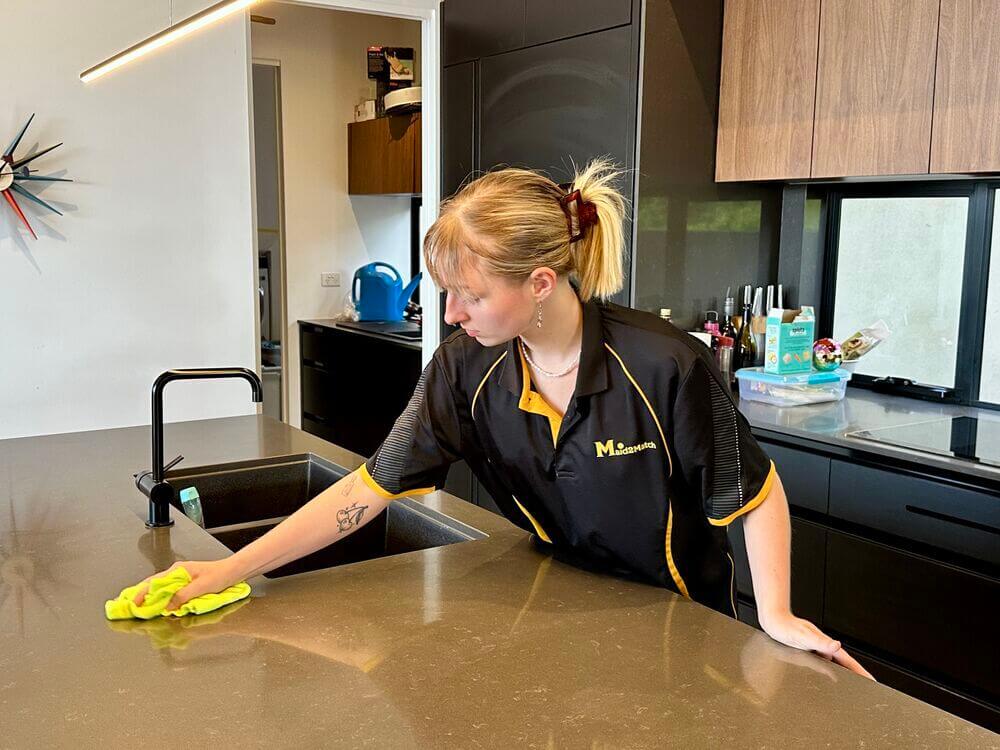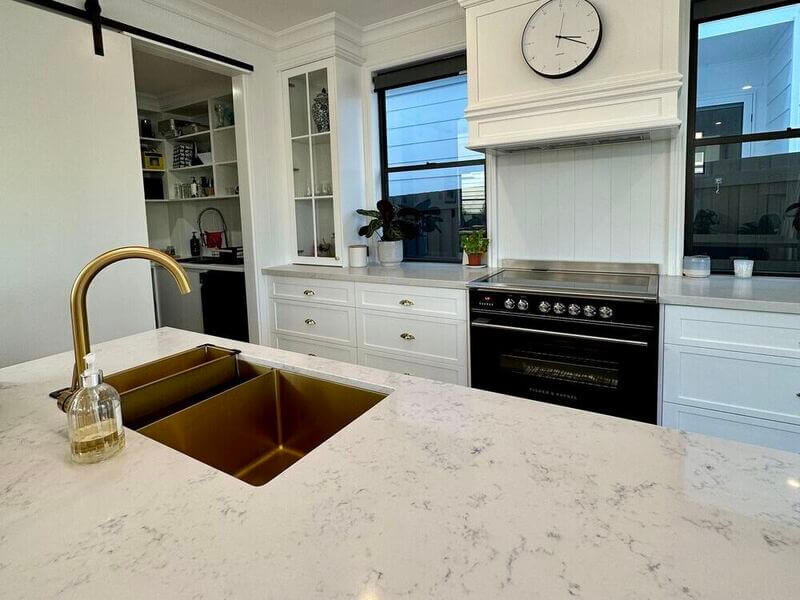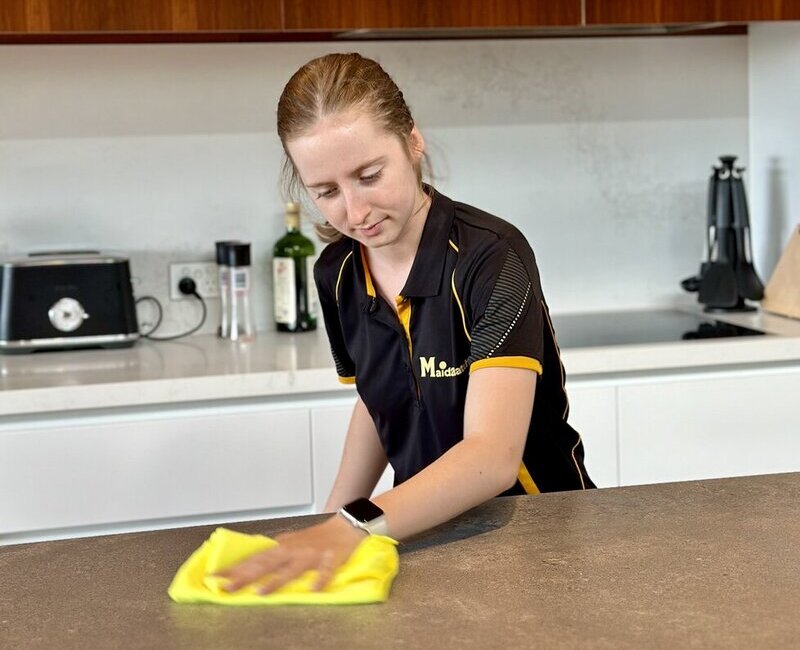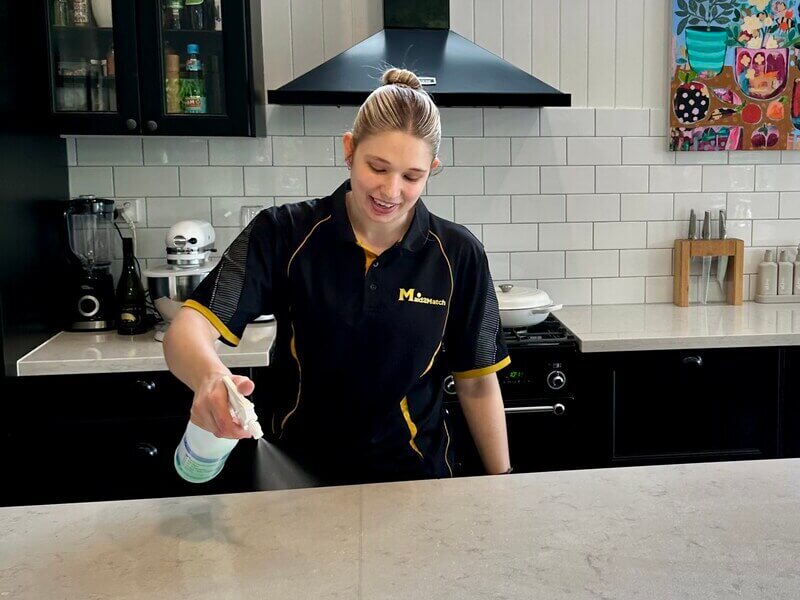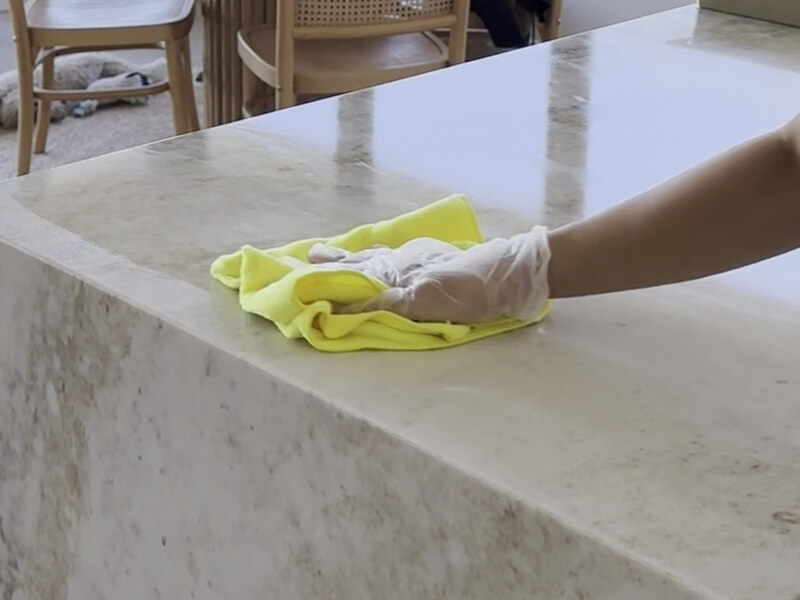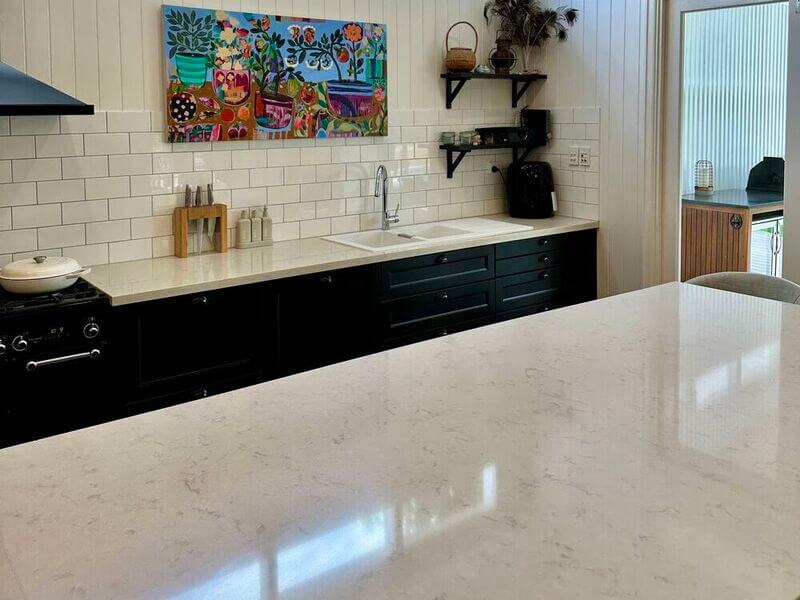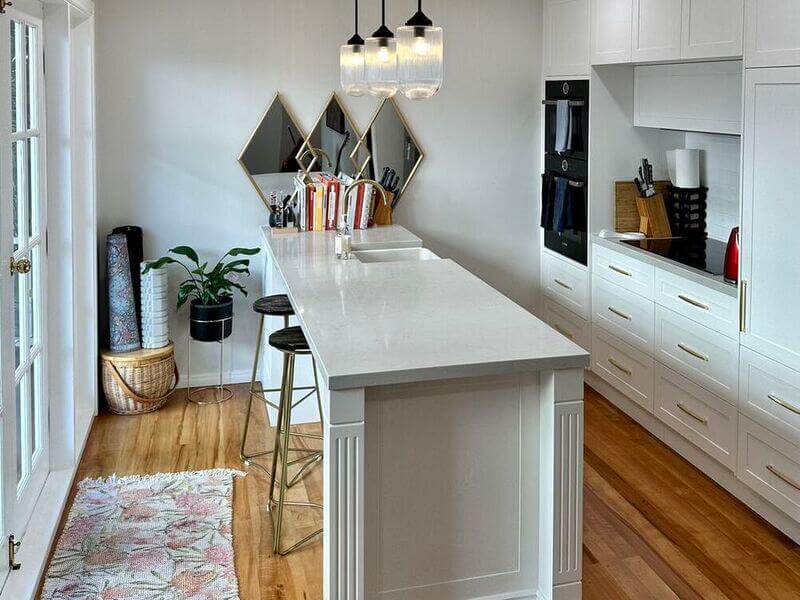Your benchtop is one of the busiest surfaces in your home. It’s where you chop veggies, mix cooking ingredients, or have your morning coffee.
It also doubles as a workspace where you sort groceries or where kids do their homework.
With all that daily use, benchtops are no stranger to crumbs and spills.
And if your benchtop is made of porous stone (like granite and marble), an everyday mess can quickly turn to stubborn stains.
So, how do you keep stone benchtops spotless?
The answer is simple: clean them regularly with a gentle dish soap and warm water.
In this blog, we’ll tell you how to clean stone benchtops so they stay sleek and shiny!
Before Cleaning | Natural Stone | Engineered Stone | Cleaning Steps | Removing Stains | Polishing | Care Tips
How Often to Clean Stone Benchtops
To keep your stone benchtop looking its best, always clean messes and spills immediately.
This helps avoid long-term damage and permanent stains on the surface.
Moreover, aim to wipe your benchtop daily, or after each use if you cook often.
You’ll also need to disinfect the surface if you handled raw meat or someone in your home has been unwell.
Lastly, do a deeper clean weekly as part of your regular kitchen upkeep. Clear the benchtop and wipe under any objects or appliances to keep everything tidy.
(And while you’re at it, it’s a great time to clean your kitchen cabinets and stovetop too!)
Before Cleaning Stone Benchtops
Stone benchtops need gentle care, so always test your cleaning product on an inconspicuous area first.
When in doubt, stick to a mild detergent or a specialised product for natural stone.
Avoid lemon juice, white vinegar, and other cleaners with acids. Stay away from harsh chemicals like ammonia and bleach, too.
These can dull the shine, or permanently discolour or etch stone surfaces.
Never use abrasive scrubbers like metal scouring pads or steel wool. Instead, opt for soft cleaning materials like a microfibre cloth or sponge.
Lastly, remember that not all stone benchtops are the same. Knowing what type you have will help you care for it properly.
Cleaning Different Types of Stone Benchtops
Stone benchtops can be made from natural (like granite and marble) or engineered (like quartz) materials.
While they all need special care, engineered stones are generally more low-maintenance than natural stones.
How to clean natural stone benchtops
Natural stone benchtops are visually appealing, but keep in mind that most types are porous and easily stained.
The most common natural stone products are granite and marble.
Granite benchtops have a speckled appearance. They’re more durable than marble, so they stand up better to heat and scratches.
On the other hand, marble benchtops have an elegant veining. They’re softer and more porous, so they’re more prone to damage and stains.
Both materials can develop ‘etching,’ or marks caused by a chemical reaction.
This happens when acidic substances (like coffee or tomato sauce) break down the stone’s natural coating and discolour the area.
To prevent staining, tackle any spills on your stone benchtop right away.
For everyday cleaning, use gentle dishwashing liquid, warm water, and a soft cloth.
Specialised cleaners for natural stone are also a great option.
Natural stone benchtops should also be re-sealed regularly to protect against moisture and stains.
Every 1–2 years is ideal, or sooner if you notice the finish losing its sheen.
How to clean engineered stone benchtops
Engineered stone benchtops (also called quartz) look like natural stone but are easier to clean.
They’re usually made from a blend of natural quartz, resins, and pigments. When combined, they form a non-porous material.
Quartz is also tougher than natural stone — it’s more scratch- and heat-resistant. And unless it’s damaged, it doesn’t need regular sealing.
To clean engineered stone (and other quartz surfaces), use a soft cloth and warm water with a little dish soap.
Although quartz is more tolerant of acidic cleaners, it’s still best to avoid these, as repeated use can corrode the finish.
NOTE: As of July 2024, engineered stone has been banned in Australia because of health concerns around silica dust.
Some people might also refer to engineered stone as “Caesarstone”, but that’s actually a brand. Their older products were quartz-based, but they now offer silica-free options.
Cleaning Steps for Stone Benchtops
To keep your stone benchtop in good shape, give it a quick clean each day or after every use.
A deeper clean weekly is ideal, too. But if the upkeep feels like a chore, let our house cleaning pros handle it!
Here’s what you need for cleaning:
- Warm water
- Paper towel
- Soft cloth or sponge
- Dish soap or pH-neutral stone benchtop cleaner
Step 1: Clean up spills and debris
Clean up any spills on your benchtop straight away!
Liquids — especially acidic or colourful ones — can stain stone benchtops if left too long.
Use a paper towel or a dry cloth to blot the liquid. Do not wipe, as that can spread the mess.
If needed, replace the towel and keep blotting until most of the liquid is soaked up.
When you’re done, brush off any solid food bits and debris from the benchtop.
Step 2: Wipe down your stone benchtop
Once the surface is clear, mix warm water and a few drops of dish soap to make a natural stone cleaning solution.
Dip a soft cloth or sponge into the soapy water, and wipe down your stone benchtop. Focus on any greasy spots or marks.
For tough stains, mix equal parts baking soda and water.
Apply the paste onto the affected area, and rub gently with a damp cloth.
Step 3 (optional): Disinfect the benchtop surface
If you handled raw meat or someone in your home has been unwell, it’s a good idea to disinfect your stone benchtop.
For light-coloured stone surfaces, mix equal parts water and 3% hydrogen peroxide in a spray bottle.
For quartz benchtops, combine 2 parts 70% rubbing alcohol with 1 part water.
Spray the solution onto the surface, let it sit for about a minute, then wipe it clean with a damp cloth.
Another option is a commercial antibacterial cleaner for natural stone materials.
Always follow the product instructions to avoid damaging the surface!
Step 4: Rinse and dry the benchtop
Rinse any leftover cleaner from your stone benchtop with a damp cloth.
Do not let it air dry to prevent water spots. Instead, wipe everything with a fresh, dry towel for a streak-free finish.
NOTE: If your benchtop has a sink, keep an eye out for splashes. Always dry the surface after using or cleaning the sink!
How to Remove Stains from Stone Benchtops
If you notice a stain on your stone benchtop, don’t let it sit! Act quickly while the mark is still fresh.
Before getting started, try to identify the type of stain so you can choose the right cleaning method.
For dark-coloured benchtops, avoid cleaners that can cause fading, such as hydrogen peroxide.
To be safe, test your method on a small, hidden area first.
Also, keep in mind that some stains may be too hard to remove. In that case, it’s best to call a stone restoration specialist.
Coffee stains
To remove coffee stains from stone benchtops, try a thick baking soda paste.
Apply it directly to the mark. Let it sit for 5–10 minutes, then wipe it off with a clean, damp cloth.
For stubborn stains, make a poultice using 1 part 3% hydrogen peroxide and 2 parts baking soda. This is safe for light-coloured stones.
Spread it over the affected area, and cover it with a plastic wrap. Let the poultice sit overnight.
Afterwards, remove the plastic wrap and rinse off any residue with a damp cloth. Finish by drying the area thoroughly.
TIP: This method can also work on other organic stains, such as food, sauces, tea, or wine.
Ink stains
For ink stains on stone benchtops, wipe the area immediately with warm, soapy water.
If the mark lingers, try using 70% rubbing alcohol. Dip a cotton pad (or swab for smaller marks) into the alcohol and gently dab the ink until it lifts.
Once the ink is gone, wipe the area with a damp cloth and dry it thoroughly with a soft towel.
Oil stains
Oil splatters can leave unsightly stains on stone benchtops, but don’t worry — there’s a way to remove them!
Start by blotting up any excess oil with a paper towel.
For fresh oil stains, sprinkle baking soda over the mark. Let it sit for about 20 minutes to allow it to draw out the oil. Afterwards, wipe away the powder with a damp cloth.
For oil stains that have already set in, make a paste using equal parts baking soda and dish soap.
Apply it to the area and leave it for 30 minutes. For tougher stains, leave it on longer, or even overnight.
Once the stain lifts, rinse any residue with a damp cloth, then dry the surface thoroughly.
Rust stains
Rust can be tricky to clean from stone benchtops. As a safe first step, apply a baking soda paste over the stain.
Let it sit for at least 30 minutes, then wipe it away using a damp towel.
If the rust is still there, try a stone benchtop stain remover that’s specifically labelled for rust.
Be sure to follow the instructions on the label carefully!
Water stains
For water marks on stone benchtops, a mixture of dish soap and warm water can help.
If that doesn’t work, apply a baking soda paste to the stain. Let it sit for 5–10 minutes, then wipe gently.
Remove all residue from your stone benchtop with a damp cloth. Then, dry the surface well when you’re finished.
How to Bring Shine Back to Stone Benchtops
Natural stones like granite and marble can lose their shine over time due to everyday wear. To restore their lustre, you need to polish them occasionally.
On the other hand, quartz typically doesn’t need polishing.
Start by giving your countertop a thorough clean. Wipe it down using a soft rag and warm, soapy water. Then dry the area with a clean cloth.
For extra gloss, choose a pH-neutral stone benchtop polish. Be sure to follow the instructions on the label carefully.
When you’re done, wipe off any residue with a damp cloth and dry the surface completely.
How to Care for Your Stone Benchtop
To keep your kitchen benchtop in great condition, wipe up spills as soon as they happen.
It’s also a good idea to use a coaster or tray under bottles, mugs, and anything that might drip.
Don’t put hot items like pots and pans directly onto the surface. Instead, place them over a hot pad or trivet.
Even though stone is heat-proof, sudden temperature changes can crack or discolour the surface.
Cutting directly on the benchtop can also cause scratches, so always use a cutting board.
And if your benchtop is made of natural stone, have it resealed yearly by a professional!
This will help protect your benchtop against stains and everyday wear.
FAQs About Cleaning Stone Benchtops
They may be a little fussy, but stone benchtops will last for years with the right care! Learn more about how to keep them sparkling.
What is best for cleaning stone benchtops?
The best thing to clean stone benchtops with is warm water and gentle dish soap.
Another option is a specific cleaning solution formulated for natural or engineered stones.
We also recommend wiping the surface with soft materials like a microfibre cloth or a non-abrasive sponge.
How can you tell if your stone benchtop needs resealing?
To tell if your benchtop needs resealing, pour a small puddle of water (about the size of a coin) onto the surface.
Let it sit for 10 minutes. If the water soaks in and darkens the stone, it’s time to have your stone benchtop resealed by a professional.
What damages stone benchtops?
While durable, stone benchtops aren’t indestructible. They can be damaged by:
- Extreme heat
- Spills like coffee, oil, and wine
- Cutting directly on the surface
- Metallic scrubbers like steel wool
- Acidic liquids like lemon juice and vinegar
- Harsh chemicals like bleach and muriatic acid
Can you use Jif on a stone benchtop?
It’s best to avoid using Jif and other similar products on stone benchtops!
While they’re great for tough grime, many cream cleansers are abrasive. They can scratch or dull the surface over time.
Some formulations may also be too acidic or too alkaline, which can damage natural and engineered stone.

